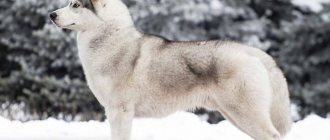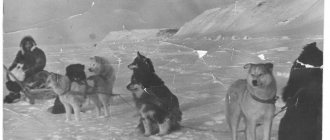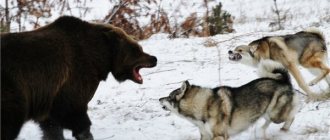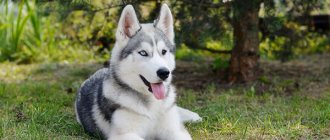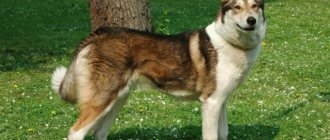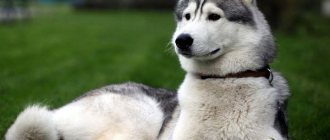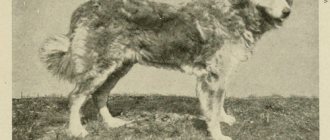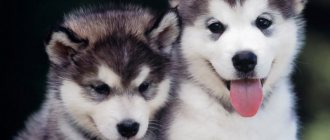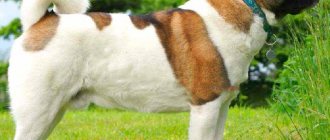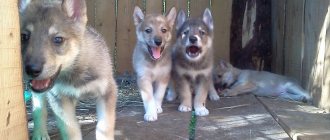History of the breed
The reindeer dog began its history more than 5 thousand years ago in Scandinavia. The direct ancestor is the Lapland peat dog. The species has undergone slight changes over its long history, and its names have also changed. Some called the breed the reindeer husky or the Lapp herder, the reindeer husky.
From the territory of the Scandinavians, the dog was transported first to the Finns, then to the Nenets. Previously, the breed was assigned exclusively to the functions of a hunter, but after the large-scale development of reindeer husbandry, the Nenets reindeer herding husky became an indispensable assistant in driving large animals.
On a note. The breed received its official name only in Russia; it is not included in the International Cynological Classification.
The Nenets Laika is a unique Arctic breed
The author aims to combine research experience of both fundamental and applied nature in the Russian Federation and beyond its borders in the study, breeding and promotion of the Nenets Laika - an indigenous tundra breed that is of particular value from the point of view of the gene pool
and as a multifunctional dog. The author presents his own experience of international and interregional project cooperation on the conservation of the Nenets Laika, whose habitat extends from the Kola Peninsula to Chukotka, Kamchatka and Koryakia.
The Nenets Laika is usually characterized as an aboriginal breed, that is, preserved in the modern history of cynology in the natural conditions of residence and economic activity of the indigenous peoples of the North. It will be important for experts and researchers of the Arctic to get acquainted with the history of the breed and the peculiarities of the formation of its standard.
There is a decrease in the number of the breed, its practical disappearance in traditional territories (in Taimyr), as well as breeds of other northern huskies (for example, Amur and Kamchatka), hybridization of the reindeer race in laboratory and natural conditions. It is necessary to preserve the homogeneous culture of the Nenets and other indigenous peoples, of which the Nenets Laika is an integral part. One of the conditions is the planned, systematic work of dog handlers, zoologists, and Russian polar explorers in its study, selection, and breeding. Arctic expeditions with my participation, where the study of reindeer-breeding huskies was one of the tasks, confirmed the hypothesis of authoritative experts in this field that in ancient times this breed was a hunter’s companion, and now remains a companion in home and agriculture (reindeer herding and other species), in demand for various business purposes. I would also like to dwell in the article on the importance of the breed in government needs and the national economy in Russia.
Nenets Laika (Reindeer Spitz, Nenets Reindeer Laika) is a breed of Central Europe that has spread to the North of Eurasia to the Northeast. It served as the basis for the creation of a number of cultivated Spitz breeds. Isolated pockets of the dog population, which were not subjected to targeted artificial selection, have been preserved in the traditional farms of the nomads of the tundra and forest-tundra of Eurasia, where they are used for herding domestic reindeer, for hunting, like nomadic dogs[1].
Accepting the conclusion of the famous paleontologist, scientist, naturalist writer, zoologist Nikolai Kuzmich Vereshchagin, based on the remains of a medium-sized Volga wolf discovered on the Dnieper, Western Transcaucasia, Yakutia and Northern China, that the wolf-like dog was probably the common ancestor of the primitive breeds of domestic dogs in the Neolithic and Bronze Ages, one should take into account the fact that the turf dog is considered by cynologists to be the ancestor of both the Nenets and other European Laikas (Lapland, Finnish, etc.). The turf dog, which did not change its appearance throughout the Stone Age and is considered the oldest known fossil breed in Central Europe, is a direct descendant of the reindeer husky. The similar shapes of the skulls of these dogs, according to scientists, serve as one of the confirmations of the above. The remains of a peat dog were found on Lake Ladoga.
The foundations for the study of huskies and Nenets huskies were laid relatively recently by the prince, governor of the Saratov province (1915-1917), the great hunter, naturalist and researcher Andrei Shirinsky-Shikhmatov, who published the “Album of Northern Dogs” in 1895[2]. It published for the first time a map of the distribution of Northern dogs, tables of their measurements, neat text and thirty photographs in color illustrations. More than ten editions were supposed, but researchers of reindeer huskies and northern dogs know only the first, surviving album. A.A. Shirinsky-Shikhmatov was the first to define and mention Laikas (Karelo-Finnish, Russian-European, West Siberian, East Siberian, Nenets) as northern dogs, that is, dogs of local residents of Northern Eurasia. An interesting fact is known that at the anniversary exhibition of the Imperial Society for Proper Hunting in 1898, the reindeer huskies Belko and Belka from the collections of Prince A.A. Shirinsky-Shikhmatov received a gold medal. This was the first official recognition of the breed's high working qualities.
Samoyeds (Nenets) communicated with Lapps (Laplanders) in the European North and as a result received from them in the first half of the 19th century a dog that acquired minor differences, which still allowed it to be classified as a separate type of breed. It was called differently: Samoyed husky, deer husky, Tavgian (Nganasan) dog, tundra herding dog, Nenets dog. Only a few synonyms are given here. I will dwell on the importance of not confusing the Nenets Laika, which we call Samoyed, with the spectacular and snow-white Samoyed - an excellent result of selection by foreign dog handlers. The breed was ideal for reindeer herders in its naturally created form thanks to the persistent instinct of searching and pursuing the animal, combined with contact and the desire to please the leader (owner). The fact that reindeer herders are in a state of hunting all year round has made the Nenets Laika an integral part of their life. Beginning in the mid-19th century, the Nenets began to use the Samoyed dog in reindeer herding, which continues to this day. Modern nomadic reindeer herding in Russia has been preserved in the territory from the Kola Peninsula to Chukotka, using the Nenets Laika as a shepherd and hunting dog. So according to B. Shirokiy and M.G. Volkova, the Nenets divide their huskies into the so-called. “first” or “industrialists”, fast dogs capable of catching up to three arctic foxes a day, and “second”, “medium” dogs that work normally for deer, but do not catch more than one arctic fox. An important pattern for the Nenets is that the better the Nenets Laika is as a hunter, the better it is as a shepherd for deer.
The Nenets Laika is mentioned in the first monograph “The Laika and Hunting with It” by M.G. Dmitrieva-Sulima in 1911. The definition of “laikas as a group of primitive dog breeds of ancient origin, which have changed little since the time of the first domestication and therefore are similar to their wild relatives not in one or two characteristics, but in their entire complex,” given by Professor N.A. Smirnov in 1936 in the collection “Laek Standards of the USSR”, also allows many researchers to classify this breed as one of the ancient ones. I consider it reasonable to base the further presentation of the material and future research on these and the above-mentioned basic definitions and hypotheses, which are available to us thanks to Boris Shiroky, a contemporary in the study of huskies in general, who distinguishes a special section in cynology - “Laika studies.”
Boris Ivanovich is a hunter, geologist, creator of nurseries in Chukotka, Kamchatka, and the Koryak Autonomous Okrug in the 70-90s of the last century, researcher of huskies, including the Nenets. He is the creator of scientific and applied science in Ukraine. Together with his son, zoologist from Saratov Oleg Shiroky, in 2021 they will publish the first and so far only modern book about all famous huskies - “Our Northern Dogs. Introduction to Like Studies.” The publication is available in electronic form. It is both a reference book and a collection of historical essays, which introduces the reader in an accessible form to issues of cynology and ethnography. The Nenets Laika is analyzed in the full breadth of the breed's capabilities, and not just as a hunting dog or a dog for agricultural needs, which was lacking in many earlier publications. In 2021, the authors of the above-mentioned book took an active part in the interregional project “Preservation of Reindeer Herding,” supported by the Arctic Development Project Office. Other authoritative international, Russian federal and regional experts took part in the project. The plans include attracting new partners and like-minded people to cooperate on the integration of successful international and Russian scientific and practical developments necessary for further research of the Nenets Laika in Russia. B. Shirokim’s experience of creating Nenets Laika nurseries in the USSR in conjunction with traditional reindeer husbandry, and in Ukraine as a private form of farming for solving research problems in the process of their selection and breeding, seems important for further interaction.
In 1909, the famous cynologist Alexander Pavlovich Mazover, who in the future would become one of the “fathers” of Soviet cynology, wrote about Nenets dogs like this:
“Of all the other breeds of northern dogs, the Nenets Laika is the most uniform in its type and is easier to train. Being in the tundra, in conditions of natural isolation from hunting dogs that are not found in these areas, as well as from populated areas with their random and mongrel dogs, the Nenets Laika is better than others preserved in its pure form in the main places of its distribution.”
In the Arctic zone of Russia, examples of such territories are the Nenets and Yamalo-Nenets Autonomous Okrugs.
I consider it important to also note the following key stages in the history of the Nenets Laika in the twentieth century. Firstly, this is the expedition of 1937 - 1940. researcher and expert on hunting dog breeding Mikhail Georgievich Volkov “Yamal-Chukotka”, thanks to which the dog gets to the reindeer herders of Chukotka and Kamchatka. In the 1940s, Nenets Laika dogs were regularly exhibited at the All-Union Agricultural Exhibition, where the breed also received due recognition. The next milestone was the development of draft rules for testing the working qualities of the breed at the Research Institute of Agriculture of the Far North of Norilsk at the site of the Naryan-Mar agricultural station of the Nenets Autonomous Okrug in 1956. This was the first attempt to standardize the breed in the USSR[3].
Speaking about the standardization of the breed, in terms of its history, it should be noted that the first unofficial standard appeared in pre-revolutionary Russia thanks to the above-mentioned researcher and connoisseur of the breed A.A. Shirinsky-Shikhmatov in 1896. In 1936, the standard of the Nenets Laika club appeared in America. In the USSR, the first description of the Lapp and Samoyed Laika appears in 1925 (based on the first one created and mentioned earlier). In 1960, a more thorough description of the Nenets Laika, the dog handler Mazover, appeared. The creation by the Scientific Coordination Council for domestic dog breeds at the Research Institute of Cultural and Natural Heritage of the Ministry of Culture and the Russian Federation and the Russian Academy of Sciences of the modern Russian breed standard became possible thanks to the work of Dr. Biology in 1985 - 1989. L.S. Bogoslovskaya and veterinarian N.A. Nosova. It is worth noting the emphasis on the importance of the riding qualities of the Nenets Laika and other northern dogs in the studies of Bogoslovskaya and Nosov, which are undoubtedly important in the traditions of reindeer husbandry in the Far East. However, combining their point of view with the point of view of Shiroky and Volkov seems more correct, since it reflects all the working capabilities of the Nenets Laika. The current breed standard, where the Nenets Laika is called “reindeer herding”, in my opinion, focuses on the use of the breed in agriculture, although the proven natural functionality is much broader. That is why a number of dog handlers, zoologists and Arctic researchers are convinced of the need to change the breed standard in terms of using a single correct name - Nenets Laika.
In 2021, as a member of the Association of Polar Explorers, I became a member of the independent international expedition “Nenets Laika” in the Malozemelskaya tundra of the Nenets Autonomous Okrug. Its conclusion was the huge interest in the UK, Australia, and Finland in the study of the Nenets Laika in order to improve the Karelian-Finnish Laika and Samoyed breed, possibly creating a new breed with the working name Arctic Spitz. Farmers in these countries are also interested in using it on their farms. Native Americans have confirmed that the Nenets Laika is very similar to the North American Indian dog.
As part of the expeditions of another NGO project, the Foundation for Economic Programs, partners from the University of Oregon and the Samish Indian Nation were presented with Russia's successful experience in preserving the distinctive Nenets culture. In the United States, indigenous peoples lost their dogs, so learning about the experience of preserving the Nenets Laika in the culture and economic activities of the indigenous peoples of the North of Russia aroused great interest among Americans.
Nenets Laikas, as part of reindeer transport battalions, along with tens of thousands of Laikas during the Soviet-Finnish and Great Patriotic War, transported the wounded from the battlefields, guarded posts, and attacked enemy deer. Historian of the Soviet-Finnish War and head of the Military Center of the Karelian Isthmus B.K. Irincheev confirms the fact of battles between reindeer transport and sabotage formations, and B.I. Shiroky in his research mentions that the Nenets set Nenets huskies against the enemy’s reindeer, depriving him of his usual transport. Today, these dogs can stand up to defend our homeland, especially if the question arises of creating an Arctic Canine Service.
Historians agree that Samoyed huskies were participants in R. Amundsen’s victorious expedition to the South Pole in 1911–1912. A little earlier, in 1899, the famous polar explorer Englishman Robert Scott took two Samoyed huskies from Arkhangelsk for breeding. The Nenets Laika was the companion of the famous traveler - naturalist E.P. Spangenberg. I cited these three facts to confirm that the Samoyed Laika is an excellent assistant in traveling over different distances, regardless of the climate zone.
The USSR Ministry of Internal Affairs noted the successful experience of using Nenets Laikas in forensic science. The Federal Customs Service of Russia uses Nenets Laika mestizos (Shakalaika or Sulimov's Dog) today and is interested in using purebred dogs in its daily work, understanding their advantages over spaniels in the ability to work year-round and unpretentiousness in everyday life. The Soviet Union had successful experience in testing and using Nenets dogs in search and rescue operations in Siberia and Kamchatka, as B. Shiroky points out in his works. This indicates a potential demand for the Nenets Laika in the service of the Russian Ministry of Emergency Situations.
President of the Association of Indigenous Minorities of the North, Siberia and the Far East, State Duma deputy G.P. Ledkov believes that it is the preservation of nomadic reindeer herding in Russia in a tradition with a thousand-year history that is the basis of the modern life of the indigenous inhabitants of the North, a certain asset. The Nenets Laika, previously a hunter, and a little later a shepherd for the natives of the tundra and taiga of Russia, is a key link in this chain. It is necessary, first of all, to create a reserve of dogs for the national economy in the Far North. Further, it will be possible to invite international experts to exchange experience without creating threats to Russia’s traditional fisheries in the Arctic.
The project “Preservation of the reindeer husky” confirmed the relevance of determining the breed’s population throughout the entire Arctic zone. Using the method of expert assessments and focus groups, the number of purebred Nenets Laikas in the pilot Nenets Autonomous Okrug was determined to be two thousand individuals. The Naryan-Mar branch of the Federal State Budgetary Institution of Science of the Federal Center for Arctic Research of the Russian Academy of Sciences "Naryan-Mar Agricultural Experimental Station" confirmed the problem of the shortage of thoroughbred reindeer races for the reindeer herders of the district[4]. Federal and regional experts of the project agreed on the need to create centers for the conservation of the breed, in which the experience of natural and scientific selection of the Nenets Laika will be accumulated, genetic analysis will be carried out, and issues of service and sport dog breeding will be resolved. The experience of Soviet, Russian and foreign scientists in creating nurseries can be combined and small innovative scientific enterprises can be created that can work in related industries such as tourism or creative industries.
In terms of tourism, I really hope that my assumption that the Nenets Laika can become a brand in the Nenets or Yamal-Nenets Autonomous Okrug will be supported by the authorities at the relevant level. A separate promising area is the training of dog handlers in the direction of “Northern Laika” or “Nenets Laika” on the basis of specialized secondary vocational educational institutions of the Nenets or Yamalo-Nenets Autonomous Okrug. The NGO "Fund of Economic Programs", the ANO "Project Office for Arctic Development", the Union of Reindeer Herders of the Yamalo-Nenets Autonomous Okrug appealed to the legislative authorities of the Nenets and Yamal-Nenets Autonomous Okrug with a request to initiate the issue of giving the Nenets Laika the status of a cultural heritage of the indigenous peoples of the North of Russia on the territory of the mentioned subjects.
Author:
I'M IN. Turov, director of the NGO “Fund for Economic Programs”, member of the MROO “Association of Polar Explorers”.
[1] Breed standard of the Nenets Laika (reindeer Spitz, Nenets reindeer Laika), approved. Russian Federation of Service Dog Breeding (1994), International Union of Cynological Clubs (UCI), (1998), Russian Cynological Federation (1999), National Russian Cynological Association (2000)
[2] Our northern dogs: an introduction to husky breeding. / Boris Shirokiy, Oleg Shirokiy [b.m.]: Publishing solutions, 2017
[3] O.A. Ibragimova, Nenets reindeer laika., Journal of the Heritage Institute, 2018/1(12)
[4] Report of the NGO “Fund for Economic Programs” on the project “Preservation of the reindeer husky” for the Project Office for Arctic Development, October, 2021.
Description and characteristics of the breed
The description of the breed consists of listing the main qualities. The Nenets Laika is the most hardy and active dog.
The dog’s strong constitution and maximally balanced psyche were formed thanks to harsh living conditions and constant presence on the tundra.
On a note. The herding nature allows the dog to be used as an excellent nanny even for a child.
The fluffy bear feels great in winter conditions
New advertisements: Nenets Reindeer Laika puppies prices
Selling a puppy, Ukraine, Dnepropetrovsk Nenets Reindeer Herding... price 2500 UAH
There are no advertisements for the Nenets Reindeer Herding Laika breed to collect price statistics. See full price statistics for puppies of the Nenets Reindeer Laika breed for several years. Prices are collected for Russia, Ukraine and separately for Moscow. Also, the graphs separately indicate prices for puppies of the Nenets Reindeer Laika breed from nurseries, and prices in regular advertisements. There are no advertisements for the Nenets Reindeer Laika breed to collect price statistics. Go back Dog breeds - a complete list of dog breeds with photos. Dog breeds in alphabetical order
Advantages and disadvantages of the breed
The dog is endowed with not only positive, but also negative qualities.
The advantages include:
- Excellent guard and hunting qualities. The dog is an excellent rescue dog and is used as a search engine and customs officer.
- The character is calm, very balanced.
- Absolute fearlessness is in the breed's blood.
- Can be used as an excellent nanny for a child.
- Reacts calmly to other animals.
- Tolerates any climatic deviations.
- It is very easy to train.
Main disadvantages:
- Not suitable for keeping in an apartment.
- Reacts poorly to dry feeding.
- Brushing the dog should become a habit for the owner, especially during the molting period.
- The price of a puppy is higher than the market average and quite high.
For reference! Finding a purebred purebred Nenets Laika is quite difficult. In the territory of the Nenets, few people monitor this; there are practically no real breeders. In other regions it is not yet so popular.
Character
These are smart and quick-witted animals that, literally from childhood, have the necessary skills that are inherited from their parents. They are hardworking. Possessing an independent character, they will nevertheless conscientiously carry out the work assigned by the owner.
They are not annoying and are never capricious, attracting attention to themselves. However, they become very attached to a person and try never to lose sight of him in order to readily fulfill any of his requests. They also communicate well with family members and will never offend children. But they treat people whom they see for the first time with caution.
One of their character traits is curiosity. They will not ignore any source of sound they do not understand; they will definitely run to find out what it is and whether there is a threat to the person and his family.
Nenets Laikas have excellent mental stability ; it is almost impossible to make them lose their temper. And one cannot expect aggressiveness from them - even when urging deer on duty, the dog can grab their legs with the so-called “light grip”, which will not cause the slightest harm to the animal.
Representatives of this breed are active and mobile, life within four walls is tiring for them, therefore, if the dog was purchased not for shepherding work, but as a four-legged friend, companion, hunter, it is best to keep it in a country house, equipping the animal with a spacious enclosure.
Breed standard
The breed standard has clear parameters and non-compliance leads to rejection. The height of an adult male varies in the range of 40-52 cm, females - 39-47 cm. The weight of the dog also depends on gender and should be 18-28 kg.
On a note. The breed standard prescribed by the Russian National Canine Federation has not changed since 2016, when it was first registered.
Head
The shape of the head externally resembles an elongated wedge, the frontal area is convex, and there is a pronounced tubercle on the back of the head.
Jaws and teeth
The bite shape is scissor-shaped, according to the standard, the incisors are located on the same line. The teeth are white, deviations are not allowed.
Nose
The nose can be colored black or brown.
Eyes
The eyes are oval in shape, they are set obliquely and are of medium size. Eye color can be light or dark brown.
Ears
The ears are triangular in shape and erect. Located high.
Neck
The neck is of medium length with maximally developed muscles, the angle is 50 degrees.
Frame
The straight, muscular back with a wide loin has a slightly convex shape. The belly is lean, the chest is oval-shaped.
Limbs
The limbs are well developed, oval-shaped paws are endowed with thick pads and very short claws.
Tail
The tail is set high. When the dog is in a calm state, it resembles the shape of a sickle; during periods of excitement, it curls almost into a ring.
Wool
The dog not only has beautiful fur, but also a thick undercoat. It does not allow moisture to pass through and is able to protect against the cold.
Important! Thanks to its beautiful fur, the pet is able to withstand even forty-degree frost.
Color
Reindeer husky fur can be of the following colors:
- Pure black or with slight tan marks.
- Brown.
- Piebald or spotted.
- There are pure white representatives of the breed.
- The red or zone-red color is the rarest species that can be found in nurseries.
Attention! By standards, specks in color are quite acceptable.
Any non-compliance with standards will result in disqualification
Disqualifying faults
For representatives of this breed the following are unacceptable:
- Deviations in height even by 2 cm.
- The appearance of age spots on the nose.
- Tiger color.
- An undeveloped undercoat and short coat are also disqualifying characteristics.
- Poorly developed muscles and loose skin.
- Muzzle too wide or narrow.
- Disproportional head.
- Large ears that droop or stand poorly.
- Worn teeth or discoloration of incisors.
- Weak back or sagging lower back.
Maintenance and care
The rules for caring for all dogs are approximately the same. It is important to observe all hygiene standards and strictly follow them.
Hygiene
Combing should be done regularly.
Since the husky has a very thick coat, daily combing is necessary during the molting period.
You should not bathe more often than once every 2-3 months.
Cleaning your nose and ears should be done weekly.
Walking, physical activity and rules of safe behavior on the street
It is recommended to keep the dog only in a private house; it is absolutely not suitable for an apartment.
The active nature of the dog requires intense walks and physical activity.
Walks should last at least 60 minutes.
Features of feeding and diet
The dog should eat meat and fish; you can add cereals and dairy products, fruits and vegetables to the diet.
Important! It is prohibited to give sweets and baked goods to pets.
Health, illness and life expectancy
Natural immunity and excellent health, unfortunately, are not complete protection against the following diseases:
- Disturbances in the digestive system.
- Liver diseases.
- Disturbances in the functioning of the heart.
With proper care and a balanced diet, dogs live 14-15 years.
Reproduction should be carried out under the supervision of a specialist and a pair should be selected carefully. It is advisable to leave such a task to a person with experience, that is, to a breeder.
How to choose a puppy
Choosing a puppy is the most important matter; a lot depends on careful attention to this issue.
You should pay attention to the basic characteristics of the breed, which must comply with generally accepted standards.
Important! It is better to buy a mate from trusted breeders who have extensive experience and have been dealing with this issue for several years.
Puppies are initially perfectly adapted to the cold
Diseases of the Swedish Vallhund
The Swedish Vallhund is a dog with northern roots, so it has fairly good health and adapts well even to harsh environmental conditions. Life expectancy with proper care is 12–14 years
When buying a puppy, you should pay attention to the health of its parents, since the breed most often has ailments that are of a hereditary nature:
- Hip dysplasia. Congenital pathology of the development of the pelvis leads to chronic dislocation, which causes pain and does not allow the animal to move normally. Having discovered that your pet is pressing its back paw and has stopped actively playing, you need to go to the hospital - the only solution to the problem is surgery.
- Retinopathy (damage to the retina). The main symptom is a noticeable deterioration in vision. If left untreated, the disease progresses and leads to blindness. The veterinarian can prescribe either medication to treat the problem or surgical intervention - everything will depend on the severity of the case.
